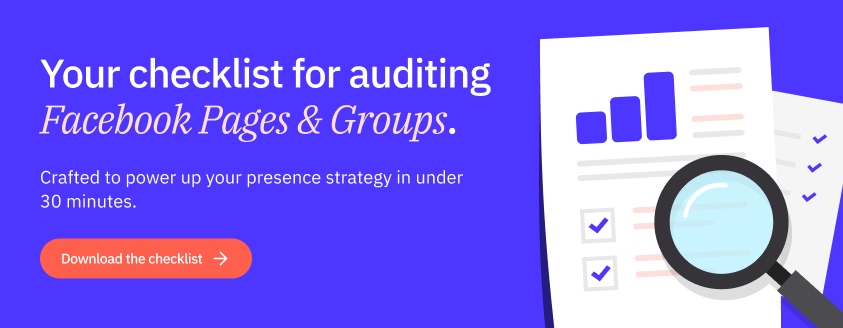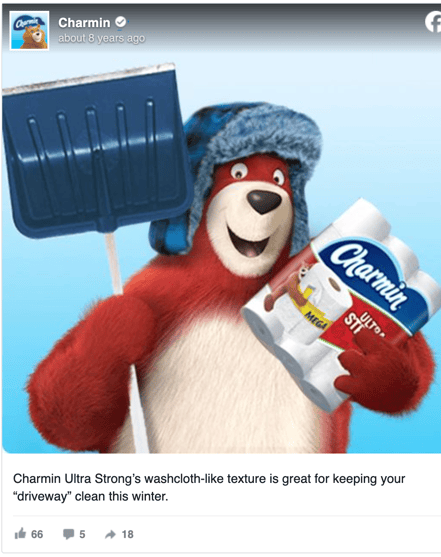Facebook is smarter than most of us! They are constantly making updates to the algorithm that make it even more difficult to ensure that your content gets in front of your target audience.
With this in mind, it’s essential to consistently audit your Facebook presence and nail down a content strategy that’s going to drive impact.
Developing brilliant, engaging content is only one hurdle; you then need to ensure that your content is being seen by the right people.
It’s not easy to create a buzz from your Facebook presence, and it doesn’t happen magically, especially with the changes to Facebook's News Feed in early 2018. Facebook is placing value on meaningful interactions and connections, therefore deprioritizing news and other public content.
Elevate your brand to new heights, or start from the very beginning with a strong foundation by making the necessary tweaks in your current processes and Facebook marketing strategy.
How do you create a winning content strategy for Facebook?
1. Set goals

You’re not getting anywhere without goals!
Setting goals and following through with them will help you focus on every action you take. Furthermore, measuring progress against set goals allows you to identify success or make necessary changes as you go.
It might seem like a simple step, but setting goals is often overlooked when it comes to a Facebook marketing strategy in general.
Don’t be fooled into thinking that having an active Facebook business page is enough. It’s not.
It's easy to be sidetracked by vanity metrics such as growing likes, but it's important to remember that your audience can be 10,000,000 people strong while only 10 of those people would subscribe to actually see your content.
Company goals
Every action should follow company-wide goals.
If the established company goal for Q4 is to drive a certain amount of new customers, ask yourself how Facebook can help achieve that goal.
It might mean taking an advertising focus and setting up a specific campaign or re-targeting leads. It might even mean starting a Facebook business page for the very first time if it is a platform you have not tapped into just yet.
Regardless, ensure that your activity provides tangible value.
Social media managers: If you’re looking for a way to prove your ROI, this is how.
Let’s say you have a new client who is a budding online women's fashion retailer. We’ll call them FringeFashion.
FringeFashion wants to grow revenue by 25%, so your Facebook marketing strategy needs to be outlined with these needs in mind.
We'll bring FringeFashion back into the equation throughout this process.
Social media goals
Apply company goals and vision to specific and tangible social media goals across each platform.
We’re talking about Facebook specifically here, so consider your resources and time commitments (see below) and how Facebook can help you achieve established goals.
One of the better ways to set goals is using the SMART guideline.
- Specific: What do we want to do?
- Measurable: How much of it?
- Achievable: How do we accomplish this?
- Relevant: Is this the right time, and are we the right people?
- Time-sensitive: When do we want to get this done?
Let’s set up SMART goals for FringeFashion based on the company goal to drive a 50% revenue growth from online orders:
- Specific: Grow revenue from online orders
- Measurable: Grow revenue from online orders by 50%
- Achievable: Grow revenue from online orders by 50% by implementing dynamic Facebook ads and posting more regularly on the Facebook business page.
- Relevant: Grow revenue from online orders by 50% by implementing dynamic Facebook ads as part of the marketing team’s Facebook marketing strategy
- Time-sensitive: Grow revenue from online orders by 25% by implementing dynamic Facebook ads as part of the marketing team’s Facebook strategy in Q4
By going step-by-step through the SMART goal process, you end up with a developed goal that is in clear alignment with company objectives!
It’s important to remember that goals are the first and last step to making any change.
Get excited about creating them and allow them to motivate your success. Look back at past successes and blunders to create well-defined and realistic objectives.
2. Determine your audience

As previously mentioned, there are 2 billion people actively using Facebook, with 1 billion of them being daily active users. That’s almost every third person in the world having a Facebook account.
Let that number sink in for a minute…
Yeah, it’s a lot. As a business, you need to cut through the clutter and connect directly with people who might need your product or service.
Facebook provides some huge value here with Facebook Audience Insights.
If you’re unfamiliar with this Facebook Business Manager feature, it provides a comprehensive look into who your target audience is and what they’re up to on Facebook.
You can get information about everyone on Facebook, the people already connected to your Facebook Page or custom built audiences. Here’s what you can discover from Audience Insights:
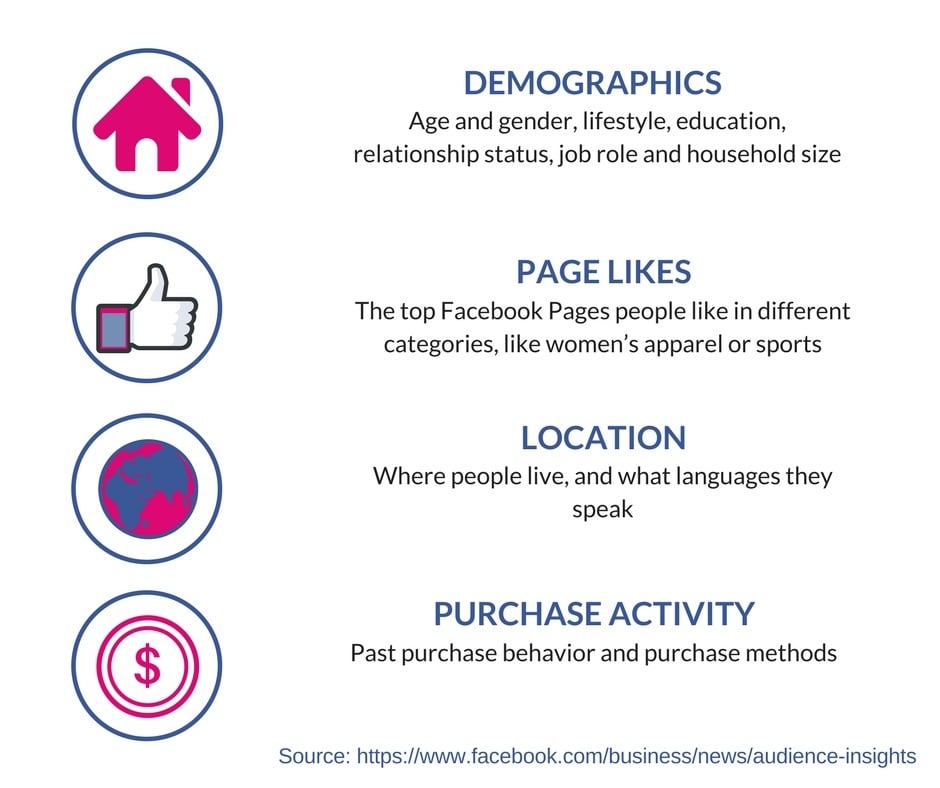
If FringeFashion used Audience Insights to look at the people already connected to their Facebook page they might find that their audience is 87% women and 13% men, most of which live in the United States and like Urban Outfitters.
They can then take this information to create Lookalike audiences to target new customers with similar interests with the Facebook Ads they’re creating in line with their SMART goal listed above.
Audience Insights is different from Page Insights because it looks at trends about your current or potential customers across Facebook, whereas Page Insights looks at the interactions on your Page (i.e., likes, comments, and shares).
Think of who your ideal customer is, check insights, and go from there.
3. Use your resources wisely

All resources are limited, from time to skills to people. Because of this, it’s important to be aware of how many resources you do have and how they’re best utilized on any given project. Being consistent with your Facebook content strategy is your number one priority right after forming goals to determine success.
People
Do you have a social media team of 10, or are you flying solo with all the company's social accounts?
This is a major factor in determining what you’re able to do on Facebook and should definitely play into how goals are set.
Are your clients going to be participating in social presence at all?
If FringeFashion sends your team pictures of what’s going on around the office on a weekly basis and a collection of new inventory details, you will have more freedom to allocate your own people to different tasks.
Time
How much of your team’s time (or your time) will be spent on social media?
If there is only one person who can spend half of their working hours on this client, your Facebook strategy will look different than someone who has a whole team working full-time on social media exclusively.
If you're using Sendible's Smart Posts feature to customize social media messages, the battle of time is already half-won!
There are lots of cool things you can do on Facebook, such as setting up Facebook Events for your webinars or a keynote event or launching a giveaway contest.
With proper planning, both of these things can be great tools, but they also take a lot of time.
There’s always going to be something else you could be doing, and there’s never going to be enough time. Don’t get overwhelmed; just be aware of the resources you have at hand and what projects will provide the biggest return.
Tools and software
Before it’s time to even write, design or create, it’s vital to establish which marketing technologies you have access to, which ones you’re using currently and what new resources you need, if anything, to succeed in meeting your goals. Do you need Adobe Photoshop, or can you get by with Canva instead?
Project management tools are a lifesaver for staying on track and maintaining a strong hold on valuable time resources.
Here at Sendible, we use Asana and Slack to plan projects, assign tasks and communicate across all teams.
Determine which tools are essential to your Facebook success and make an argument to have access to those tools.
Likewise, re-evaluate tools that you might not be using to their full potential or ones that are no longer useful to you.
Personally, I couldn’t go a day without Canva because of how easy it is to create streamlined designs.
When you have a post ready for publishing, consider using a scheduling tool like Sendible that can help with scheduling, adding visuals to your content, and tracking performance at the end of all of your hard work.
Sendible's optimal time feature will also help you figure out the best time to post on social platforms to hit the best engagement metrics possible.
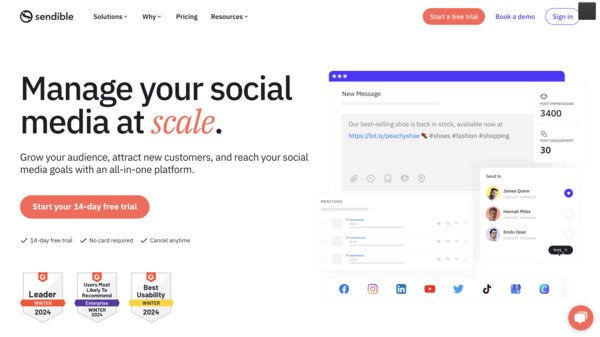
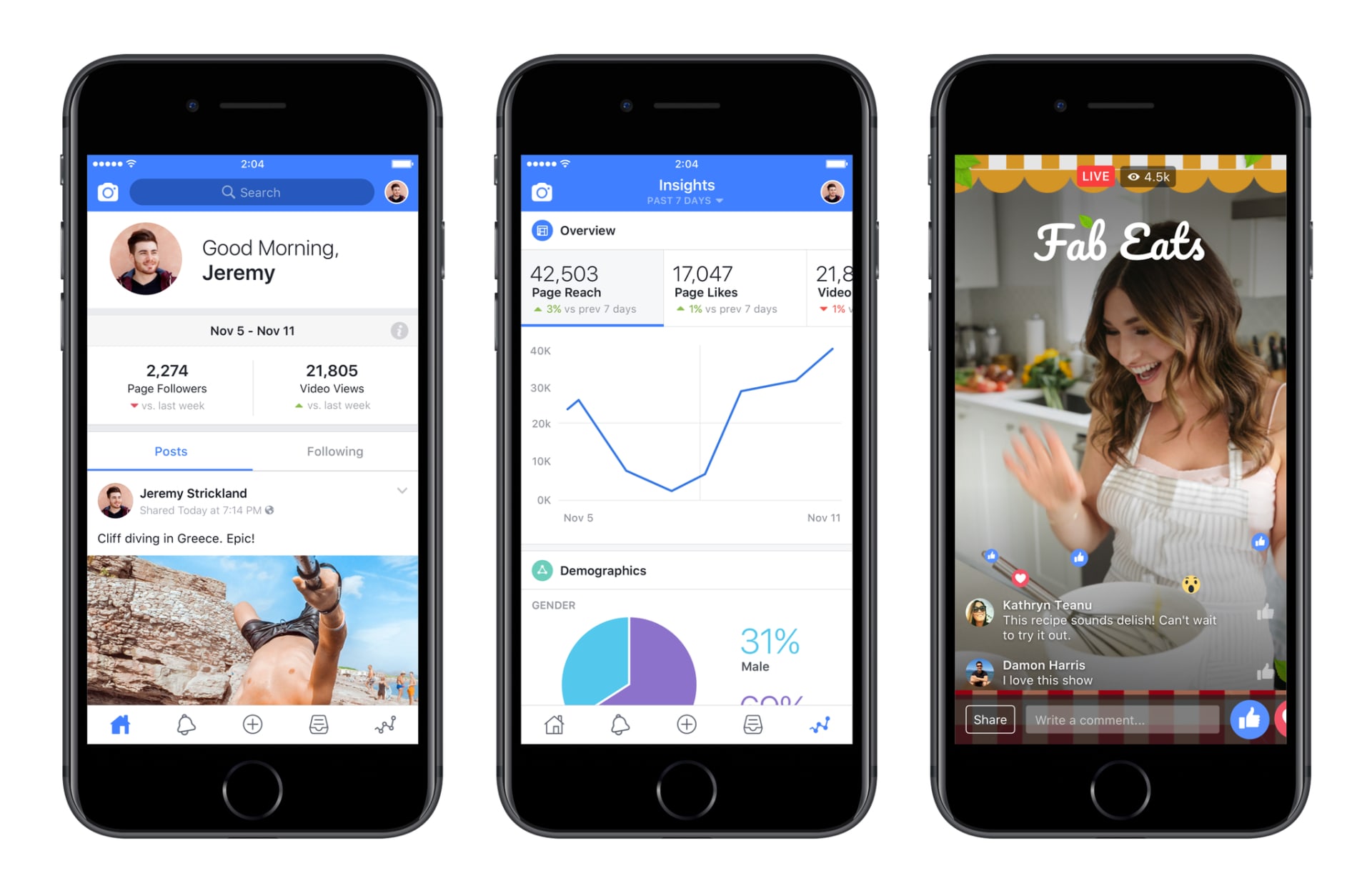
Timing Triumph: Discovering When Is the Best Time to Post on Facebook for Maximum Engagement
4. Outline your branding

Branding is the way your organization is perceived. It’s a way to humanize your brand and ensure that the same voice and message shine through, no matter how many people are communicating on behalf of the Company. Aim for your brand to be exactly what your target customer needs you to be.
This is important to your content strategy because when you start creating content, each Facebook post should be in line with this established message.
Tone and voice
Voice is one of the best ways to unify your brand and connect with your audience. When several team members create content and write copy, there are going to be multiple voices, but each voice should align with overall brand standards.
Think about the message you want to put across, what you want people to think about your brand, and how you can achieve that by the tone that resounds from your content and online communications.
Keep your brand guidelines in mind in every communication opportunity on Facebook, from creating your bio to chatting with customers.
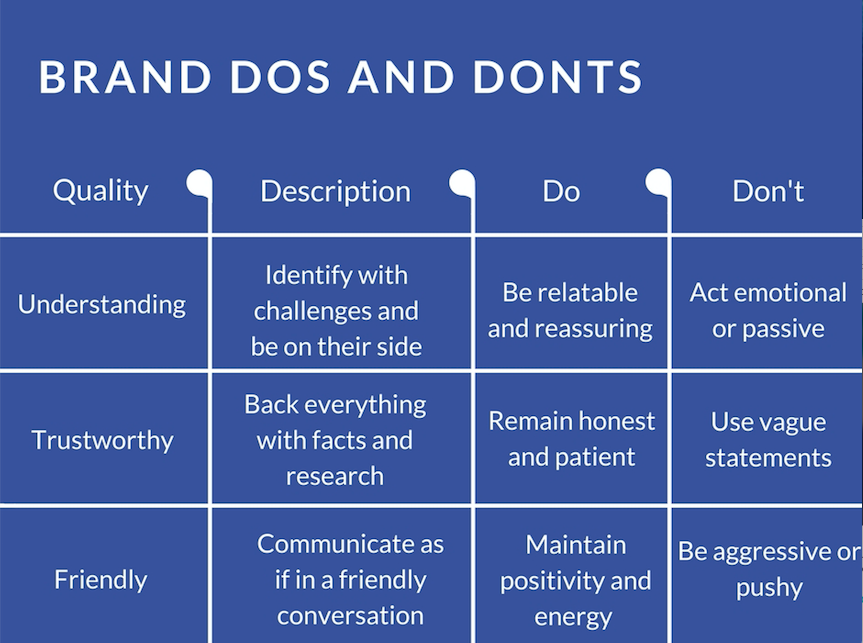
Design
Design elements make your brand easily recognizable and continue the story of what your mission is.
Furthermore, branding doesn’t stop at a company’s logo, and you don’t need to be a graphic designer to create visuals that are within brand guidelines.
Keep colors, fonts, and shapes in mind when creating content for Facebook to ensure you are set apart from what others are doing while still being in line with your brand.
Remember to only add text when it can’t be avoided, especially for Facebook ads.
If you aren't a little different than your competition, you're in trouble.
- Mark Sanborn
5. Build creative content

All of the above elements come together in the content creation process. You should aim to educate your audience and solve their problems by producing content that is useful and shareable. But how do you do that in short posts?
Visuals
Thirty-seven percent of marketers think visual marketing is the most important form of content for their business, second only to blogging (38%).
Why? People engage with visual content on social media.
Get creative with it; share quotes with images, infographics, charts, and, my personal favorite, memes. Have a joke to crack? Make a meme with Meme Generator.
Charmin did this with their own Facebook page and drove engagement up:
Video
Facebook’s algorithm favors video that is uploaded directly to their site, so set your sights on making video a priority when it’s possible.
You don’t have to have a professional video team to make this work. Tools like Animoto and GoAnimate allow marketers to create high-quality videos with ease.
We’re talking about Facebook here, so consider Facebook Live.
Facebook Live videos are even more prioritized than other forms of video content! Moreover, live streams are watched 3x longer and receive 10x more comments than pre-recorded videos.
Writing
Nothing beats good writing, whether it’s blogging or just writing copy for social media posts.
As mentioned earlier, that’s what speaks to an audience on behalf of your brand. Contribute your unique perspective and point of view and aim to create value with everything you say.
Take an edutaining position on Facebook, aiming to equally educate and entertain your audience.
Write content and copy that is fresh, casual, and clear. Tell a story. Ask questions. Provide a call to action.
Here are some writing resources if you need a little push:
- Ideaflip: Digital brainstorming board to inspire and refine ideas
- Hemingways: Streamlined virtual editor that tweaks structure and suggests changes
- Grammarly: Your online spell-checker, ensuring every piece of writing is mistake-free
6. Create a schedule and get ready to engage

You now know who your audience is, but when are they online and more likely to be engaging with your content?
Use Facebook Page Insights to continuously test which content is getting the most engagement at certain times.
There is no magic number for how often you should post to Facebook each week, but the lmore you post, the more people each post will reach.
With each post gaining more reach, your engagement is likely to go up with this strategy too.
With less business content being shown on News Feeds, designate more time to engage with your audiences and encourage them to follow your content.
It’s essential to respond to comments, monitor messages, and ‘take the pulse’ of the content that you’re putting out. You could be increasing your reach tenfold if you reach out to brands that are included in your content, possibly gaining a shoutout.
Touch into relevant Facebook Groups to share and circulate content and tag other brands and people whenever you can.
If content is king, conversation is queen
-Joe Munsell
Over to you
There is no ‘one size fits all’ fix for Facebook content strategy, it’s going to fluctuate from business to business.
If you know your goals, audience, resources, and brand guidelines, you’re in an excellent position to create meaningful content that is going to make an impact.
But remember, keep tracking your progress to make any amends as you go with your marketing to truly achieve your goals.
What do you think is the most essential element of creating a Facebook content strategy? Let us know what has worked (or hasn’t worked) for you in the comments below!

